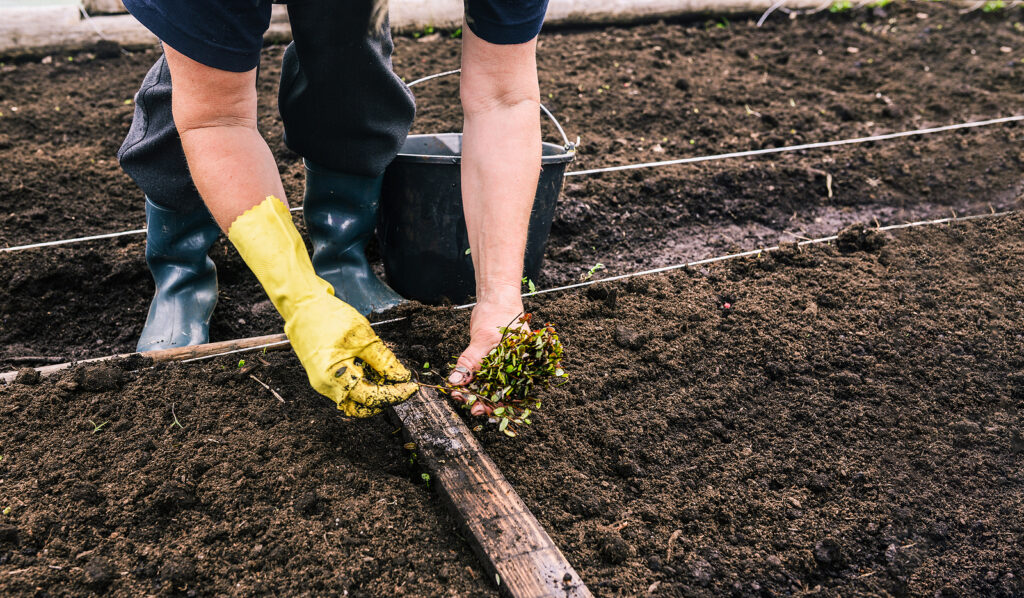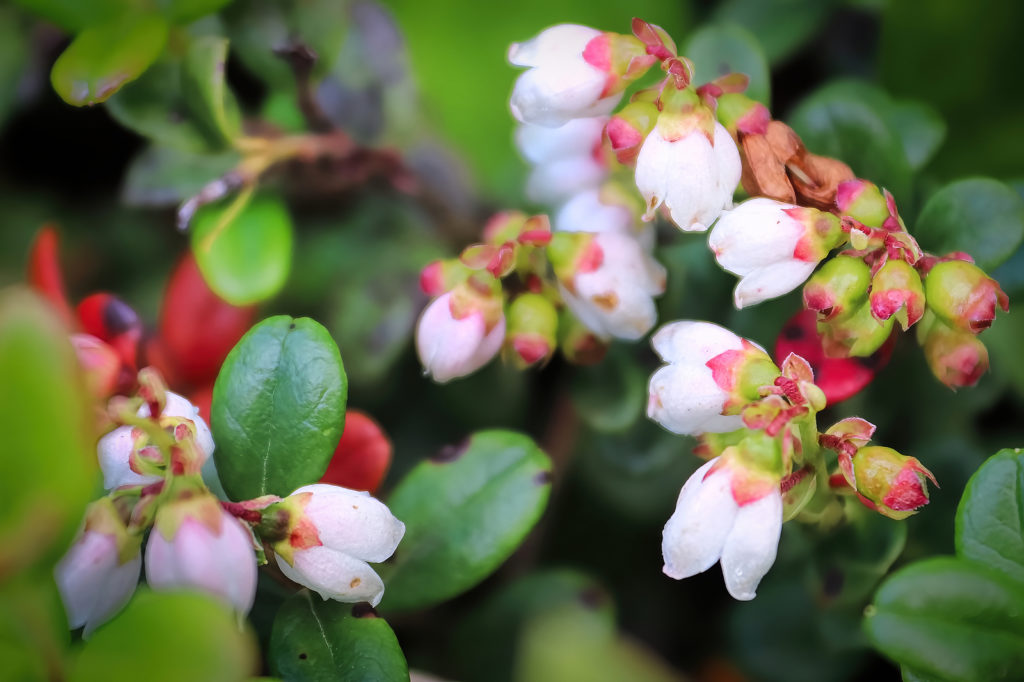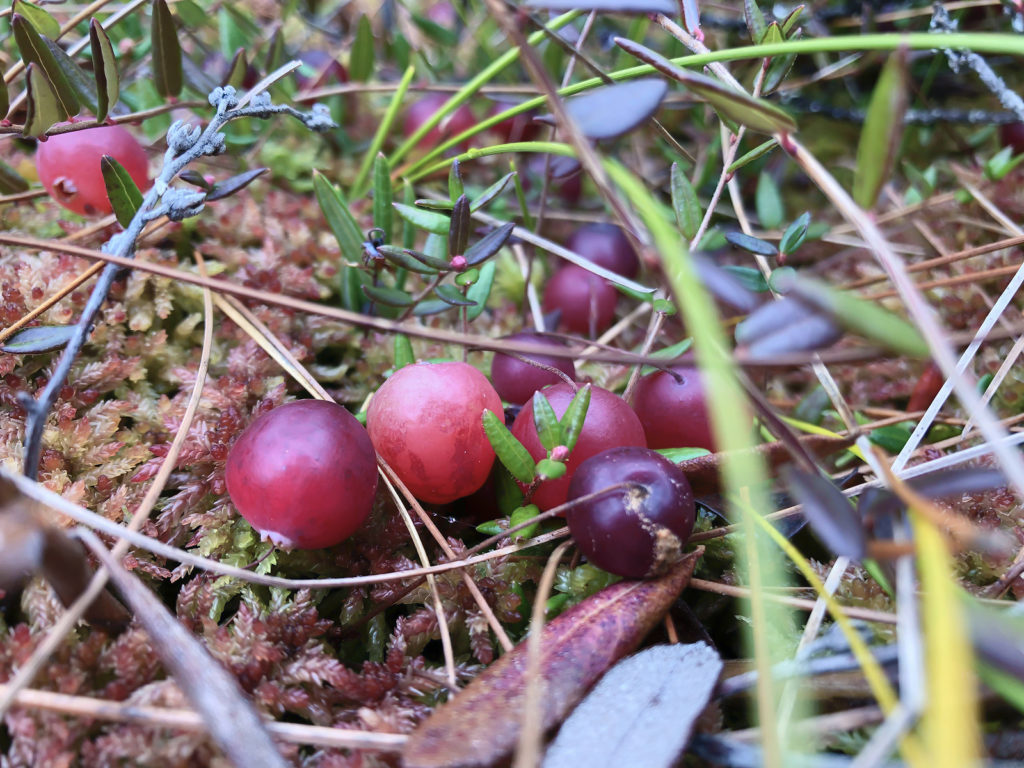Cranberries are not hard to grow if you give them the conditions they need. They require cool temperatures, soil rich in organic matter (acidic peat soil is best), and plenty of water.
Because cranberries have specific requirements, home gardeners usually have the best success growing cranberries in containers or specifically constructed cranberry beds. Most often cranberries are grown in a cranberry bog–usually located on a cranberry farm dedicated to the crop.
Related article:

The cranberry is a low, creeping, evergreen shrub, very nearly a vine. It has a woody stem that runs along the ground. Stems can grow 6 or 8 feet long. Upright shoots grow from the stems of the cranberry vine. Bright red berries form at the top of the shoots from pink flowers.
Cranberry fruit is small and tart. The ripe fruit is deep red.
The high acidity of the cranberry makes it excellent for relishes and jellies. Cranberries will add zest to salads, stuffings, cakes, muffins, pies, and puddings. Cranberry juice is refreshing and can be used in punches and cocktails.
Best climate and site for growing cranberries
- Cranberries grow best in USDA Zones 4 to 7. Cranberries require a growing season of three months of chilly winter weather (about 1,000-2,500 hours) at 32°to 45°F to ensure flower set and fruit in spring.
- Plant cranberries in full sun but not in a location that gets too hot; a south-facing location is not optimal.
- Cranberries thrive in moist, well-drained, humus-rich soil. They are often grown on sandy or peaty bogland. Cranberries can grow in ordinary acid soil. Planted in ordinary soil add plenty of aged compost or other organic matter and use an aged compost of shredded leaf mulch to protect plants in the winter months.
- Cranberries grow best in acid soil; a soil pH of 4.0 to 5.5 is optimal.
- Grow cranberries on a raised bed or in a sunken bed where you can control the acidity of the soil and drainage.
- Plants do not tolerate dry soil, but they can withstand flooding in cold weather.
Cranberry pollination
- Cranberry flowers are self-pollinating; honeybees and bumblebees will increase the size of the berries and the size of the crop.
Spacing cranberries
- Cranberries grow to 1 foot high and wide or slightly larger. The stems root where they touch the ground and continue to grow larger.
- Space cranberries 1 to 2 feet apart.

Planting cranberries
- Plant cranberries in autumn where winters are mild. Plant cranberries in spring where winter is cold; plant after all danger of frost has passed. Avoid planting cranberries in hot, dry weather.
- Prepare the planting bed by mixing shovelfuls of acid peat into the soil before planting.
- You can make a special bed for cranberries; set an old bathtub or animal watering trough in the ground, line a sunken bed with ceramic tile, then fill it with an acidic potting mix.
- Dig a hole half again as deep as the root ball and twice as wide; moisten the hole before planting.
- Plant cranberries so that the soil mark of the nursery pot is level with the soil of the new planting hole.
- Plant cranberry cuttings on 12- to 18-inch centers. Dig a hole a little larger than the rootball and mix a little bone meal into the soil before setting the young plant in place.
- Backfill the hole with half-native soil and half-aged compost or commercial organic planting mix. Firm in the soil to be sure no air pockets remain around the roots.
- Water the new plant with a high phosphorus liquid starter fertilizer.
- Keep the soil evenly moist as the plant begins to grow.
- Cranberry planting beds are not covered with water; this is a popular misconception.
Cranberry care
- Keep the ground where cranberries grow weed-free for several years until the stems cover the ground and upright shoots have made a strong stand.
- Cranberries grow in only the top 6 inches of soil, which must be kept constantly moist.
- When the soil is frozen, cranberries can be dried or killed by winds; protect the plants from wind.
- To counteract drying, planting areas can be flooded in winter.
- A topdressing of grit or sand will help retain soil moisture and keep down weeds.

Container growing cranberries
- Grow cranberries in a container that is at least 12 to 18 inches wide and about 8 inches deep (cranberry roots usually grow just 4 to 6 inches deep).
- Fill the container with acidic potting mix and coarse, lime-free grit to improve drainage; place the pot in a saucer topped off with water so the soil never dries out then plant.
- An alternative to growing cranberries in a pot is to construct a bed of perforated plastic (use a pre-formed rectangular plastic pond). Fill the bed with acidic potting mix or low pH soil; cover the surface with a layer of lime-free grit or sand to act as a mulch then plant; established plants will spread to form a mat-like ground cover.
How to water cranberries
- Cranberries require a lot of water; keep the soil constantly moist. Cranberries root into only the top 6 inches of soil which must be kept moist.
- Tap water can be alkaline; use rainwater or filtered water when possible.
- A top dressing of grit or sand across the planting bed will help retain moisture and keep down weeds.
How to feed cranberries
- Cranberries do not require regular feeding; apply a lime-free, liquid general fertilizer in mid-spring.
- A fish emulsion fertilizer with a 2-4-2 ratio is ideal for cranberries.
- Keep the soil weed-free until shoots create a thick mat covering the soil.
- Renew the mulch or grit or sand periodically; you can also mulch with sawdust.
Pruning cranberries
- Prune or trim cranberries in spring to keep them bushy; removing runners will keep plants compact and bushy.
- Prune cranberries so that they do not become overcrowded. Prune by cutting away some of the sprawling stems and some of the upright fruiting stems. Prune so that the remaining stems have room to grow on.
- Remove dead or damaged stems when pruning. Take a few inches off of runner tips to encourage the growth of fruit-bearing stems.
Propagating cranberries
- Cranberries are commonly propagated by stem cuttings which root readily. Growing cranberries from seed can take 3 to 5 years to produce fruit.
- Seeds require a period of cold stratification before sowing; place them in the refrigerator for about 3 months before sowing.
- Grow seeds in 3- to 4-inch pots; place two seeds in each pot planted about 1/4 inch deep.
- Seeds germinate quickest at about 70°F. Seeds germinate in 3 to 5 weeks. Grow seedlings on at about 60 to 75°F.
- Cranberries are usually grown from 6 to 8-inch cuttings that are taken from upright shoots in spring before terminal buds begin to sprout.
- Remove all but the top four or five leaves and any flower buds; dip the cut end into a powdered rooting hormone. Place the cutting about 4 inches deep in a potting medium and place it in a warm place to root.
- Set cuttings on 18-inch centers in peaty soil with an inch of cutting above the ground.
- Where winters are mild, set rooted cutting outdoors in fall or set them out in early spring.

How to harvest and store cranberries
- Cranberries are ready for harvest when they are fully colored, deep red, usually in autumn. Berries that are pink or white are not ripe. Red fruit is ripe.
- Cranberries are usually harvested by hand or by a mechanical harvester. Commercial growers use a wet harvest method; they flood the field to cover the plants with 6 to 8 inches of water. Ripe fruit floats to the surface for collection. In the home garden, the planting bed does not need to be flooded.
- Ripe berries can stay on the bush for a month or two as long as there is no freezing weather; pick cranberries as you need them.
- Frost will damage the berries so harvest before freezing temperatures.
- Berries are too tart to eat raw; add sugar and use them in juices, jellies, muffins, and cranberry sauce.
- Cranberries will keep in the refrigerator for two to three months in an airtight plastic bag or container; they also can be frozen.
Cranberry kitchen uses
- Cranberries can be made into jam, jelly, condiment, and sauce.
- Cranberries can be pressed for juice.
- Fresh cranberries keep for 3 weeks. They do not freeze well.
- Dehydrated cranberries can be eaten as a snack or added to cereal and oatmeal or to a summer salad.
Cranberry pests and diseases
- Yellowing leaves are a sign of chlorosis; it can be lime-induced; leaves yellow at the edges and yellowing spreads between the veins which remain green; apply chelated iron.
- Cranberry fruitworms bore into fruits; they eat the seeds and exit. Fruitworms are the larvae of a Sparganothis moth. Use pheromone lures to trap moths.
- Spotted fireworm is the larvae of a moth; fireworms eat fruit; control adults with pheromone lures to traps.
- A viral disease called false blossom is spread by leafhoppers; control these insects. Once infected with a virus, cranberry plants can not be saved.
Get to know cranberries
- Botanical name: Vaccinium macrocarpon (commonly grown in North America); V. oxycoccus is commonly grown in Europe
- Family: Ericaceae; another member of this family is blueberries
- Origin: Widely distributed throughout the arctic and temperate regions.
- Type of plant: Prostrate, mat-forming evergreen shrub with slender shoots and elliptic-oblong, dark green leaves to 3/4 inch long. Cranberries grow to a height of 8 to 18 inches tall.
- Flowers: Pendent, slender-stalked, bell-shaped, pink flowers, 1/2 inch across with 4 slender, reflexed lobes in clusters of 2 to 10.
- Fruit: Spherical red berries to 3/4 inch across.
- Common growing or hardiness zones: USDA Zones 2-7; most American cranberry growers are located in the Northeast.
Cranberry varieties to grow
- There are more than 100 different cranberry cultivars that grow in North America. Traditional varieties include: ‘Early Blacks’, ‘Howes’, ‘Stevens’, ‘Searles’, ‘Ben Lear’, ‘McFarlain’. Other cultivars include: ‘Crimson Queen’, ‘Mullica Queen’, ‘Demoranville’, Other varieties of cranberry available from the Grygleski family include: ‘GH1’, ‘BG’, ‘Pilgrim King’, ‘Valley King’, ‘Midnight Eight’, ‘Crimson King’, ‘Granite Red’.
- ‘Pilgrim’ is one of the most popular and widely grown varieties. It bears numerous large berries. Berries are red and can grow to the size of cherries.
- ‘Early Black’ is not black but rather a rich, dark red-purple. This variety produced mediums size berries that are usually ready for harvest before other varieties.
- ‘Franklin’ is a cross between ‘Early Black’ and ‘Howes.’ This is a compact variety, ideal for containers.
- ‘CN’ is a spreading variety that produces heavy crops of large, juicy red berries.
Also of interest:
Related articles:
Planning the Home Fruit Garden
Garden Planning Books at Amazon:
- Vegetable Garden Almanac & Planner
- Kitchen Garden Grower’s Guide Vegetable Encyclopedia
- Vegetable Garden Grower’s Guide
- Tomato Grower’s Answer Book
More fruit-growing articles:
Learn how to plant, grow, prune, and harvest your favorite fruits. Click below for all you need to know.
- Apple
- Apricot
- Avocado
- Banana
- Blackberry
- Blueberry
- Cantaloupe
- Chayote
- Cherimoya
- Cherry
- Citrus
- Clementine
- Cranberry
- Currants
- Elderberry
- Feijoa
- Fig
- Gooseberry
- Grape
- Grapefruit
- Guava
- Kiwifruit
- Kumquat
- Lemon
- Lime
- Loquat
- Mandarin
- Mango
- Melon
- Mulberry
- Muskmelon
- Nectarine
- Olive
- Orange
- Papaya
- Passion Fruit
- Peach
- Pear
- Persimmon
- Pineapple
- Pineapple Guava
- Plantain
- Plum
- Pomegranate
- Pumpkin
- Quince
- Raspberry
- Strawberry
- Tangelo
- Tangerine
- Tangor
- Watermelon



